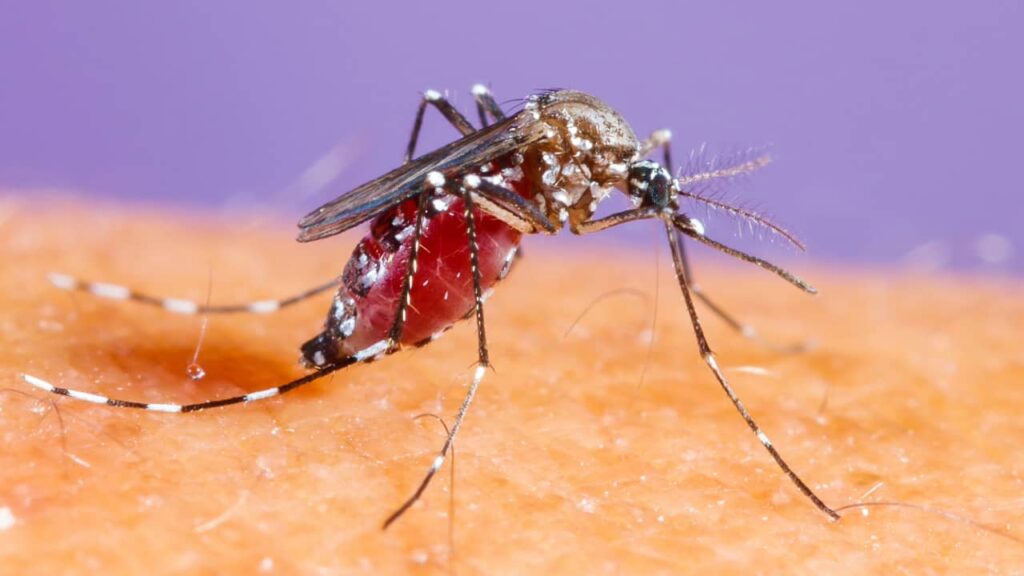Triple EEE or Eastern Equine Encephalitis Virus is a rare and an ominous disease that is caused by virus transmitted by the mosquitoes.
The virus causes neurological disease in both man and horse and they commonly develop severe disease that is frequently fatal or leaves them severely disabled.
Although EEE in humans is a rather rare phenomenon, its possible outcomes are rather severe, which is why EEE becomes a significant problem for public health in the regions where its cases were identified, such as Hampstead, NH and Massachusetts.
Table of Contents
- What is the EEE or Eastern Equine Encephalitis Virus?
- How Does EEE Virus Spread?
- EEE Virus in the United States: A Regional Threat
- Symptoms of EEE: More on What to Watch For
- EEE in Horses
- Risk Factors and Vulnerable Populations
- Diagnosing Eastern Equine Encephalitis Virus:
- Preventing EEE: Protecting yourself and Your community
- Public Health Measures: Reply for MA and Hampstead, NH
- Need to Be Alert and Educated
- FAQ Section of Eastern Equine Encephalitis Virus
- Key Takeaways
- Disclaimer
What is the EEE or Eastern Equine Encephalitis Virus?
EEE stands for Eastern Equine Encephalitis and is pathogen from the family of Alphavirus and it is transmitted through a bite from an infected mosquito.
This belongs to the group of the mosquito transmissible states and other related viruses are the Western Equine Encephalitis and Venezuelan Equine Encephalitis viruses.
The disease is bird to bird and mosquito to mosquito, and it is most commonly found in freshwater hardwood swamps.
People and horses are known as “dead end species” meaning people can catch it and become carriers but they are not involved in the further transmission of the virus.
How Does EEE Virus Spread?
EEE virus is mostly acquired through the bite of the mosquito that is mostly the Culiseta melanura species.
These mosquitoes are found in swampy regions; they feed on birds the main host of the virus.
Horse and humans cannot get other people sick but the chances of getting infected are high in areas that mosquitoes are densely populated.
The virus exhibits a periodic nature, and most of its occurrences are from the late spring to the early fall, and this, especially after rains that trigger breeding of mosquitoes.

EEE Virus in the United States: A Regional Threat
Though EEE seldom occurs experts consider some parts of the United States including Massachusetts and Hampstead, NH highly vulnerable zones.
These regions have recorded sever human cases over the years and Massachusetts is one of the affected states by this virus.
EEE in Massachusetts
EEE has been reported in Massachusetts on and off with the virus recurring every few years.
The state has put in place massive measures that include surveillance, spraying and disbursement of information that aims at reducing infection rates of mosquitoes.
Massachusetts has recorded some of the recent cases of EEE in the recent past and this has made the health officials to come up with warnings and alerts.
EEE in Hampstead, NH
Residents in Hampstead, NH are also at a risk of being affected by EEE especially because this region loves in New England.
The town has taken multi-faceted measures that can safeguard its people from menace such as conducting periodical checks on the presence of the mosquito and the application of control measures.
These are normally given out during the period when it is most common to see mosquitoes around with the intention of repeating the message to the public.
Symptoms of EEE: More on What to Watch For
Symptoms of Eastern Equine Encephalitis Virus are usually mild or severe sometimes there may be no symptoms at all. Nevertheless, here several symptoms arise, and once they develop, they are usually acute and potentially fatal.
Early Symptoms
Fever: The major indices of EEE disease include a sudden onset of high fever that is the first clinical manifestation of the infection.
Headache: They then accompanied with other symptoms such as severe headaches.
Chills: Common and early sign include, fever.
Severe Symptoms
As the infection progresses, more severe symptoms may develop, including:
Neck Stiffness: This is the sign of encephalitis which is inflammation of the brain.
Confusion: The person suffering from the disease may develop symptoms such as confusion while infected by the virus.
Seizures: Fits are one of the most frequent and dangerous manifestations of EEE.
Coma: In severe cases, the symptoms of EEE can be very serious and can progress to coma in some instance and death.

EEE in Horses
In fact, horses are at higher risk with EEE than humans.
Symptoms of EEE in horses may include:
- Fever
- Lethargy
- Anorexia
- Depression
- Muscle tremors
- Weakness
- Seizures
- Coma
If you think your horse may have EEE, please inform your veterinarian.
Risk Factors and Vulnerable Populations
While anyone can contract EEE, certain groups are at higher risk for severe disease:
Children: Adults and children of a younger age are at a higher risk of getting severe symptoms.
Older Adults: People who are aged fifty plus years are in higher risk.
People with Weakened Immune Systems: Persons belonging to the risk groups having weakened immunity of their body are more prone to be infected by EEE.
Diagnosing Eastern Equine Encephalitis Virus:
Diagnosis of the EEE is done clinically together with laboratory examination.
Doctors will expect to see some signs of encephalitis like neck stiffening as well as confusion in patients.
Laboratory tests may include:
Blood Tests, Chest X-ray and CT scan:
To exclude acute lung injury or pneumonia which can be caused by viruses and to find out whether the patient has developed antibodies or if the virus RNA is present in the patient’s system or not.
Lumbar Puncture:
To look for features of infection in the cerebrospinal fluid samples.
Brain Imaging:
A physician may also use an MRI or CT to check for brain inflammation.
Lifestyle changes are also discouraged for patients with this disease because early diagnosis is important and can significantly enhance the patients’ quality of life.
Treatment Options for Eastern Equine Encephalitis Virus
Regrettably, EEE cannot be treated by antiviral drugs, although multiple symptoms associated with it can be reasonably helpful.
As with most cancer treatments, it is mainly palliative, designed to help manage symptoms and minimize the risk of problems arising.
Treatment may include:
Hospitalization: Majority of severe EEE cases present to the hospital, Majority of patients with severe EEE get admitted.
Respiratory Support:
In extreme cases, the patients may require equipment such as the mechanical ventilators.
Medications:
Seizure medications may be symptomatic treatments, require long-term administration depending on the severity of the disease.
Since there is no specific cure for EEE; prevention becomes the best way to deal with the virus.
Preventing EEE: Protecting yourself and Your community
Prevention of EEE is centered mostly on the minimization of contact with mosquitoes.
Use Insect Repellent:
Use of EPA-recommended repellents with DEET, picaridin or oil of lemon eucalyptus.

Clean Standing Water:
Mosquitoes breed in stagnant water, one should use a broom to get rid of water from containers, gutters among other places.
Wear Protective Clothing:
It is recommended that as much skin area as possible should be covered up; this can be done with long sleeved blouses and trousers, as well as socks.
Avoid Peak Mosquito Activity Time:
Dengue-transmitting mosquitoes are those that transmit EEE virus and they are only known to be more active at nighttime.
People especially those in the vulnerable areas such as in Hampstead, NH, and Massachusetts should also facilitate local mosquito control initiatives.
Public Health Measures: Reply for MA and Hampstead, NH
Massachusetts and Hampstead, NH have established maximum preventive and control measures on the spread of this deadly disease.
Mosquito Control Programs: Scheduled fogging and administration of larvicides for the control of mosquitoes.
Surveillance: The mosquito activity and any operation related to testing EEE are to be continually monitored.
Public Education: Awareness raising initiatives which have the goal of making people better informed about EEE threat.
All these endeavours are forward looking towards safeguarding residents and minimizing the possibilities of occurrences of further outbreaks.
Need to Be Alert and Educated
Education of the public helps in preventing EEE by minimizing the chances of contact with the infected mosquitoes.
People living in such towns as Hampstead, NH and some towns in Massachusetts should ensure that they monitor any activities of these insects and take preventive measures very seriously.
Community, school, and healthcare providers are some of the entities which have a crucial role in raising awareness.
FAQ Section of Eastern Equine Encephalitis Virus
What is the mortality rate for EEE in humans?
EEE can be fatal in humans and the fatality ratios depends with the extent of the sickness.
Can EEE be transmitted from person to person?
No, EEE cannot be transmitted from one person to another person.
What is the Triple EEE Virus?
EEE is one of the most hazardous virus borne diseases from mosquito bites which leads to severe neurological disorder in human and equines.
How long does it take for EEE symptoms to appear?
A: EEE symptoms usually manifest themselves within 2 to 14 days of contraction of the virus.
What are the signs in EEE?
Signs and symptoms of the condition include fever, headache, neck stiffness, confusion, seizures, and coma in the extreme phases.
How is EEE diagnosed?
It is diagnosed through physical examination, blood test, spinal tap, and CT/MRI scan.
Does EEE have a cure or any treatment?
No specific treatment for EEE exists, and the management is thus symptomatic.
What measures should be taken regarding EEE?
A: Measures of personal protection include applying insect repellent, wearing protective clothing, using mosquito nets, avoiding being out during the peak mosquito activity, disposing of any standing water around homes and mosquito immediate environments.
Key Takeaways
- EEE is real and is a virus that passes from the bite of infected mosquitoes and sometimes causes fatal results.
- Tripel EEE or Eastern Equine Encephalitis is a dangerous viral infection that may occur in horses and humans.
- EEE is most prevalent in Massachusetts and Hampstead, NH.
- The treatments of EEE are usually administered in severe cases and can include complications such as fever, headache, stiff neck, fatigue, nausea and vomiting, diarrhea, confusion, seizures, and coma.
- There is no direct cure for EEE, but there are methods in which one can avoid contact with the mosquito thus avoiding the vector that spreads EEE.
- Both informing the public about the disease, as well as educating them on measures that should be taken to prevent EEE are considered crucial in the fight against the disease.
Disclaimer
This article is purely informative and is not relevant to any medical advice.
It is always important to seek professional advice from a healthcare provider regarding any medical issues or EEE concerns/questions.
With a keen eye for detail and a love for exploring the latest trends, DHT Writes delivers engaging and insightful content that keeps readers informed and inspired. When not writing, DHT Writes enjoys diving into new DIY projects, exploring cutting-edge tech, and keeping up with the latest celebrity happenings. Follow DHT Writes for a fresh perspective and expert advice on the topics that matter most.







